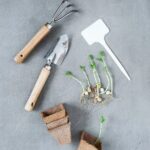Container gardening has become increasingly popular as a creative and practical way to bring the beauty of nature into small spaces. From balconies and patios to urban rooftops, containers offer endless possibilities for growing flowers, herbs, and vegetables.
In this article, we will explore the world of container gardening and provide a comprehensive guide to help you get started on your own vibrant garden oasis. Whether you are a seasoned gardener or a beginner with limited outdoor space, there are countless container gardening ideas to inspire your green thumb.
When it comes to container gardening, the options are truly limitless. From traditional terracotta pots to repurposed buckets and wooden crates, choosing the right containers is an essential first step in creating a successful garden. We will discuss various types of containers, materials, and sizes that work best for different plants and spaces.
In addition to discussing the best plants for container gardening and tips for proper maintenance, we will also delve into creative DIY projects and unique styling ideas to elevate your garden design. Whether you are aiming for a lush botanical paradise or a modern minimalist display, this article will guide you through the exciting world of container gardening.
Choosing the Right Containers for Your Garden
When it comes to container gardening, choosing the right containers is essential for the success of your garden. The type of container you use can greatly affect the health and growth of your plants. There are a wide variety of containers available, so it’s important to consider several factors before making your selection.
First, consider the material of the container. Terracotta and ceramic pots are popular choices for their aesthetic appeal, but they can be heavy and breakable. Plastic and resin containers are lightweight and durable, making them a practical option for many gardeners. Additionally, fabric or canvas containers are breathable and offer excellent drainage for plant roots.
Next, think about the size of the container. The general rule of thumb is that larger containers retain moisture better than smaller ones and provide more space for root growth. However, smaller containers can be suitable for herbs and small flower varieties.
Lastly, consider the style and design of the container. Some gardeners prefer uniformity in their container choices for a cohesive look, while others enjoy mixing different sizes and styles for visual interest.
In summary, when choosing containers for gardening ideas, it’s important to consider the material, size, and design to ensure that they suit both your gardening needs and personal preferences.
| Container Material | Advantages |
|---|---|
| Terracotta/Ceramic | Aesthetic appeal |
| Plastic/Resin | Lightweight and durable |
| Fabric/Canvas | Breathable with excellent drainage |
Creative Container Gardening Ideas for Small Spaces
Container gardening is a versatile and practical way to add greenery and color to any small space, whether it’s a tiny apartment balcony or a compact urban patio. With the right containers and creative ideas, you can turn even the smallest outdoor area into a beautiful garden oasis. Here are some creative container gardening ideas for small spaces:
- Vertical Gardens: Utilize the vertical space by installing a trellis or hanging planters to grow climbing plants such as ivy, jasmine, or strawberries.
- Suspended Gardens: Hang multiple lightweight containers from the ceiling or railing to create a suspended garden with an array of colorful blooms and foliage.
- Repurposed Items: Get imaginative by repurposing everyday items like old tires, milk crates, or wooden pallets as unique containers for your plants. This not only adds character to your space but also reduces waste.
Another great idea for small-space container gardening is to create a “garden in a box,” which involves grouping together several containers of different sizes and shapes to form an attractive arrangement. This approach allows you to mix and match various plants while maximizing limited space.
Whether you’re working with a small balcony, patio, or even just a windowsill, there’s always room for creativity when it comes to container gardening. By thinking outside the box (or should we say “container”?), you can transform any petite area into a stunning garden sanctuary.
The Best Plants for Container Gardening
Container gardening is a versatile and popular way to cultivate plants in small spaces, making it suitable for urban dwellers or those with limited outdoor areas. When it comes to choosing the best plants for container gardening, there are many options to consider depending on your climate, the size of your containers, and the amount of sunlight they receive.
One of the key factors to consider when selecting plants for container gardening is their size and growth habit. Compact or dwarf varieties of vegetables, herbs, and flowers are well-suited for containers as they don’t require as much space as their full-sized counterparts. Some popular choices for container gardening include tomatoes, peppers, lettuces, strawberries, basil, petunias, marigolds, and pansies.
In addition to size, it’s important to choose plants that are suited to the amount of sunlight your containers receive. Some plants thrive in full sun while others prefer partial or even full shade. For example, herbs like rosemary and thyme enjoy plenty of sunlight while ferns and hostas do well in shaded areas. By matching your plant choices with the conditions of your space, you’ll set yourself up for success with your container garden.
When it comes to maintenance and care of container gardens, proper watering and fertilizing are essential factors for success. It’s important to keep an eye on soil moisture levels and provide nutrients to your plants regularly since container soil can dry out more quickly than garden beds. With careful plant selection and attention to their needs, anyone can create a beautiful and thriving container garden.
| Best Plants for Container Gardening | Light Requirements |
|---|---|
| Tomatoes | Full sun |
| Let tuces | Partial shade |
| Basil | Full sun |
| Petunias | Full sun to partial shade |
Tips for Properly Maintaining Container Gardens
Proper maintenance is key to keeping your container gardens thriving and looking beautiful. Here are some essential tips for taking care of your plants in containers for gardening ideas:
1. Watering: Proper watering is crucial for container plants, as they can dry out more quickly than plants in the ground. Check the moisture level of the soil regularly and water when it feels dry about an inch below the surface. Be sure not to overwater, as this can lead to root rot.
2. Fertilizing: Container plants will need regular feeding since they have limited access to nutrients in the soil. Use a balanced, water-soluble fertilizer according to the instructions on the package, typically every two weeks during the growing season.
3. Pruning and Deadheading: Regular pruning and deadheading are important for maintaining the health and appearance of your container gardens. Remove dead or fading flowers to encourage new growth and prevent disease.
4. Pest Control: Keep an eye out for pests that may attack your container plants, such as aphids or spider mites. Inspect your plants regularly and take appropriate measures if you notice any signs of infestation.
5. Seasonal Maintenance: Finally, make sure to adjust your maintenance routine according to the changing seasons. This may include repotting, refreshing the soil, or moving plants indoors during colder months.
By following these maintenance tips, you can ensure that your container gardens continue to thrive and bring beauty to your outdoor space.
DIY Container Garden Projects
Container gardening is not only a great way to add greenery to your space, but it also allows for endless creativity and personalization. DIY container garden projects are a fun and satisfying way to express your individual style while adding a touch of nature to your home or outdoor area.
Repurposed Containers
One of the most exciting aspects of container gardening is the opportunity to repurpose items that aren’t traditionally used as planters. Get creative by using old teapots, wooden crates, mason jars, or even tires as unique and eye-catching containers for your plants. Not only does this add character to your garden, but it’s also an eco-friendly way to upcycle items that might otherwise end up in the trash.
Vertical Gardens
For those with limited space, vertical gardening offers an innovative solution. Consider creating a pallet garden by securing planters to a wooden pallet and hanging it on a wall or fence. Another idea is to use hanging shoe organizers filled with soil and plants, providing a convenient and space-saving way to grow herbs, flowers, or succulents.
Miniature Garden Terrariums
Terrariums are another popular DIY container garden project that brings a touch of whimsy indoors. By using glass bowls or jars, you can create miniature landscapes filled with tiny plants, decorative rocks, and other natural elements. These charming terrariums add visual interest to any room while requiring minimal maintenance.
With these DIY container gardening projects, the possibilities are endless. Whether you choose to repurpose unconventional containers, implement vertical garden designs, or create charming terrariums, experimenting with different ideas will enhance the beauty of your space while reflecting your personal style.
Container Gardening for Beginners
Container gardening is a great way for beginners to start their journey into the world of gardening. It offers a manageable and low-maintenance option for those with limited space or experience. Whether you live in an apartment, have a small patio, or just want to add some greenery to your home, container gardening is a fantastic solution. Here are some step-by-step tips to help beginners get started with their own container garden.
Choose the Right Containers
The first step in creating a successful container garden is choosing the right containers. When selecting containers for gardening ideas, it’s important to consider size, drainage, and material. Look for containers that are large enough to accommodate the root systems of your chosen plants, have proper drainage holes, and are made from materials that will withstand outdoor conditions.
Select the Best Plants
Once you have your containers ready, the next step is to choose the best plants for your container garden. When it comes to selecting plants, consider factors such as sunlight exposure, water requirements, and temperature tolerances. For beginners, it’s recommended to start with easy-to-grow plants such as herbs, salad greens, flowers like petunias and marigolds, and compact vegetables like tomatoes and peppers.
Care and Maintenance
After setting up your container garden with the right containers and plants, it’s important to provide regular care and maintenance. This includes watering according to each plant’s specific needs, fertilizing appropriately throughout the growing season, pruning as necessary to promote healthy growth, and monitoring for pests or diseases. By following these simple steps and staying attentive to your container garden’s needs, even beginners can enjoy success with their own thriving mini-garden oasis.
Styling and Designing Container Gardens for Visual Impact
When it comes to container gardening, not only can it be a practical way to grow plants in small spaces, but it also offers the opportunity to create eye-catching and visually impactful displays. Styling and designing your container gardens is an essential part of the process, as it can elevate the overall aesthetic of your outdoor or indoor space.
To create a visually impactful container garden, consider incorporating a mix of plant sizes, textures, and colors. This diversity will add visual interest and dimension to your display. For example, pair tall, spiky plants with cascading ones for a dynamic contrast. Additionally, vary the heights of the containers themselves to add depth to your arrangement.
Another important aspect of styling and designing your container garden is choosing containers that complement your plants and overall design scheme. Consider using different materials such as ceramic pots, wooden crates, or metal buckets to add variety and personality to your display. Don’t be afraid to get creative with repurposed items like old tires or antique milk cans for a unique touch.
Finally, when styling and designing your container gardens for visual impact, don’t underestimate the power of accessories. Incorporating decorative elements like fairy lights, colorful pebbles, or ornamental figurines can enhance the overall look and feel of your display.
Be mindful not to overcrowd your containers with too many accessories; instead, aim for a balanced and harmonious composition that draws attention without being overwhelming. By following these tips and getting creative with different containers for gardening ideas, you can achieve stunning visual impact with your container gardens.
Container Garden Inspiration
In conclusion, container gardening offers a world of possibilities for gardeners with limited space or those simply looking to get creative with their gardening projects. As discussed in this article, the right containers are crucial for successful garden growth, and there are countless ideas and options to explore when it comes to styling and designing your container gardens.
From repurposed household items to vertical gardening solutions, there is no shortage of unique and unusual container ideas for gardening. The key is to think outside the traditional flower pot and consider the potential of everyday objects as vessels for your plants. This can not only add visual interest to your garden but also minimize waste by giving new life to old items.
Whether you opt for DIY projects or simply experiment with different materials and styles, the possibilities are endless when it comes to container gardening ideas. With the right knowledge about plant compatibility, proper maintenance, and design principles, anyone can create a stunning container garden that suits their space and style. So dive into the world of creative container gardening and let your imagination run wild with unique and unusual container ideas.
Frequently Asked Questions
What Is the Best Container for Container Gardening?
The best container for container gardening depends on the specific needs of the plants being grown. Generally, containers should be large enough to accommodate the plant’s root system, have drainage holes, and be made of durable materials like plastic, clay, or wood.
How Do I Make My Container Garden Look Nice?
To make your container garden look nice, you can consider using a variety of plant types, colors, and textures to create visual interest. You can also add decorative elements like mulch, rocks, or ornaments to enhance the overall aesthetic.
What Do You Put in the Bottom of a Container Garden?
Putting something in the bottom of a container garden is essential for drainage and preventing soil compaction. Many gardeners use materials like gravel, broken pottery pieces (called “pot shards”), or even packing peanuts to create a space at the bottom of the container where excess water can collect before draining out through the holes.

Welcome to my gardening blog! I am passionate about plants and enjoy sharing my knowledge and experiences with others. In this blog, I will write about everything related to gardening, from tips on how to get started to updates on my own garden projects.





